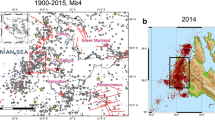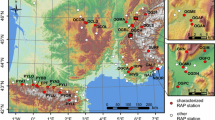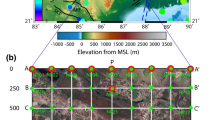Abstract
Strong motion data are essential for seismic hazard assessment. To correctly understand and use this kind of data is necessary to have a good knowledge of local site conditions. Romania has one of the largest strong motion networks in Europe with 134 real-time stations. In this work, we aim to do a comprehensive site characterization for eight of these stations located in the eastern part of Romania. We make use of a various seismological dataset and we perform ambient noise and earthquake-based investigations to estimate the background noise level, the resonance frequencies and amplification of each site. We also derive the Vs30 parameter from the surface shear-wave velocity profiles obtained through the inversion of the Rayleigh waves recorded in active seismic measurements. Our analyses indicate similar results for seven stations: high noise levels for frequencies larger than 1 Hz, well defined fundamental resonance at low frequencies (0.15–0.29 Hz), moderate amplification levels (up to 4 units) for frequencies between 0.15 and 5–7 Hz and same soil class (type C) according to the estimated Vs30 and Eurocode 8. In contrast, the eighth station for which the soil class is evaluated of type B exhibits a very good noise level for a wide range of frequencies (0.01–20 Hz), a broader fundamental resonance at high frequencies (~ 8 Hz) and a flat amplification curve between 0.1 and 3–4 Hz.













Similar content being viewed by others
References
Balan SF, Ioane D, Cioflan C, Panea I, Apostol B, Malita Z, Chitea F, Anghelache MA (2014) Scenarios for local seismic effects of Tulcea (Romania) crustal earthquakes—preliminary approach of the seismic risk characterization for Tulcea city. In: Bostenaru D, Armas M, Goretti A (eds) Earthquake hazard impact and urban planning. Springer, Dordrecht, pp 85–103
Bard PY (1999) Microtremor measurements: a tool for site effects estimation. In: Irikura K, Kudo K, Okada H, Sasatani T (eds) The effects of surface geology on seismic motion. Balkema, Rotterdam, pp 1251–1279
Dal Moro G (2008) VS and VP vertical profiling and poisson ratio estimation via joint inversion of Rayleigh waves and refraction travel times by means of bi-objective evolutionary algorithm. J Appl Geophys 66:15–24
Dal Moro G (2014) Surface wave analysis for near surface applications. Elsevier, Amsterdam, p 244
Dal Moro G, Ferigo F (2011) Joint analysis of Rayleigh and love wave dispersion for near-surface studies: issues, criteria and improvements. J Appl Geophys 75:573–589
Dal Moro G, Pipan M, Gabrielli P (2007) Rayleigh wave dispersion curve inversion via genetic algorithms and marginal posterior probability density estimation. J Appl Geophys 61(1):39–55
Diaz J, Villasenor A, Morales J, Pazos A, Cordoba D, Pulgar J, Garcia-Lobon JL, Harnafi M, Carbonell R, Gallart J, TopoIberia Seismic Working Group (2010) Background noise characteristics at the IberArray Broadband Seismic Network. Bull Seismol Soc Am 100(2):618–628
Evangelidis CP, Melis NS (2012) Ambient noise levels in Greece as recorded at the Hellenic Unified Seismic Network. Bull Seismol Soc Am 102(6):2507–2517
Field EH, Jacob KH (1995) A comparison and test of various site-response estimation techniques, including three that are not reference-site dependent. Bull Seismol Soc Am 85(4):1127–1143
Ghica DV, Grecu B, Popa M, Radulian M (2016) Identification of blasting sources in the Dobrogea seismogenic region, Romania using seismo-acoustic signals. Phys Chem Earth Parts A/B/C 95:125–134
Grecu B, Raileanu V, Bala A, Tataru D (2011) Estimation of site effects in the eastern part of Romania on the basis of H/V ratios of S and coda waves generated by Vrancea intermediate-depth earthquakes. Rom J Phys 56:563–577
Grecu B, Neagoe C, Tataru D (2012) Seismic noise characteristics at the Romanian broadband seismic network. J Earthq Eng 16(5):644–661
Grecu B, Negoe C, Tataru D, Borleanu F, Zaharia B (2016) Analysis of seismic noise in the Romanian-Bulgarian cross-border region (submitted to Journal of Seismology)
Grecu B, Neagoe C, Partheniu R, Nastase E, Zaharia B (2017) New seismic noise model for Romania, science and technologies in geology, exploration and mining. In: Proceedings of 17th International Multidisciplinary Scientific Geoconference, pp 285–292, Eds. STEF92 Technology Ltd (ISBN 976-619-7408-00-3)
Ibs-von Seht M, Wohlenberg J (1999) Microtremor measurements used to map thickness of soft sediments. Bull Seis Soc Am 89(1):250–259
Ionesi L (1989) Geologia Romaniei: unitati de platforma si orogenul Nord Dobrogean (translated title: The geology of Romania: platform units and the North-Dobrogean orogen). Thesis, Univ. Al. I. Cuza, Iasi, Romania. p 253 (in Romanian)
Konno K, Ohmachi T (1998) Ground-motion characteristics estimated from spectral ratio between horizontal and vertical components. Bull Seis Soc Am. 88(1):228–241
Lermo J, Chávez-García FJ (1993) Site effect evaluation using spectral ratios with only one station. Bull Seismol Soc Am 83(5):1574–1594
Matenco L, Bertotti G, Cloetingh S, Dinu C (2003) Subsidence analysis and tectonic evolution of the external Carpathian-Moesian Platform region during Neogene times. Sed Geol 156:71–94
McNamara DE, Buland RP (2004) Ambient noise levels in the continental United States. Bull Seis Soc Am 94:1517–1527
Nakamura Y (1989) A method for dynamic characteristics estimation of subsurface using microtremor on the ground surface. QR Railw Tech Res Inst 30:25–33
Oncescu MC, Marza V, Rizescu M, Popa M (1999) The Romanian earthquakes catalogue between 984 and 1997. In: Wenzel F, Lungu D (eds) Vrancea earthquakes: tectonics, hazard and risk mitigation. Kluwer Academic Publishers, Berlin, pp 43–47
Peterson J (1993) Observation and modeling of seismic background noise, U.S. Geol. Surv. Tech. Rept. 93–322, pp 1–95
Philips WS, Aki K (1986) Site amplification of coda waves from local earthquakes in central California. Bull Seism Soc Am 76:627–648
Popa M, Oros E, Dinu C, Radulian M, Borleanu F, Rogozea M, Munteanu I, Neagoe C (2016) The 2013 earthquake swarm in the galati area: first results for a seismotectonic interpretation. In: Vacareanu R, Ionescu C (eds) The 1940 Vrancea Earthquake. issues, insights and lessons learnt. Springer International Publishing, Switzerland. https://doi.org/10.1007/978-3-319-29844-3_17
Radulian M, Mandrescu N, Panza GF, Popescu E, Utale A (2000) Characterization of seismogenic zones of Romania. In: Panza G, Radulian M, Trifu C (eds) Seismic hazard of the Circum-Pannonian Region. Birkhäuser, Basel, pp 57–77
Raileanu V (2006) Annual report for the Contract no: 31 N/23.01.2006, Project—Advanced research of the disaster management of the strong Romanian earthquakes, Director of the project dr. Raileanu V., NIEP
Sandulescu M (ed) (1984) Geotectonica Romaniei (translated title: Geotectonics of Romania). Tehnica, Bucharest, p 335 (in Romanian)
Site Effects Assessment using Ambient Excitations (SESAME) European project (2005) Deliverable D23.12—Guidelines for the implementation of the H/V spectral ratio technique on ambient vibrations: measurements, processing and interpretation. http://www.sesame-fp5.obs.ujf-grenoble.fr
Stutzmann E, Schimmel M, Patau G, Maggi A (2009) Global climate imprint on seismic noise. Geochem Geophys Geosyst. https://doi.org/10.1029/2009GC002619
Acknowledgements
This work was partly supported by a grant from the Romanian National Authority for Scientific Research and Innovation (ANCSI)-UEFISCDI, project number PN-II-RU-TE-2014-4-0701 and partly by a project carried out within Nucleu Program, supported by ANCSI, project number PN 16 35 01 01. The authors express their thanks to Viorel Pirvu who helped with the active seismic measurements performed at seismic stations.
Author information
Authors and Affiliations
Corresponding author
Ethics declarations
Conflict of interest
On behalf of all authors, the corresponding author states that there is no conflict of interest.
Rights and permissions
About this article
Cite this article
Grecu, B., Zaharia, B., Diaconescu, M. et al. Characterization of site conditions for selected seismic stations in eastern part of Romania. Acta Geophys. 66, 153–165 (2018). https://doi.org/10.1007/s11600-018-0117-2
Received:
Accepted:
Published:
Issue Date:
DOI: https://doi.org/10.1007/s11600-018-0117-2




